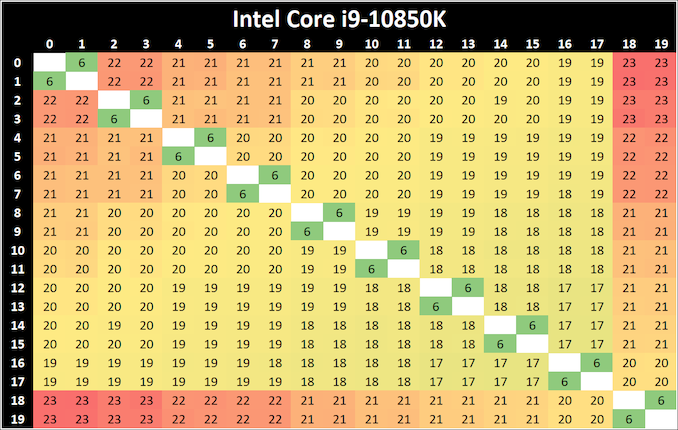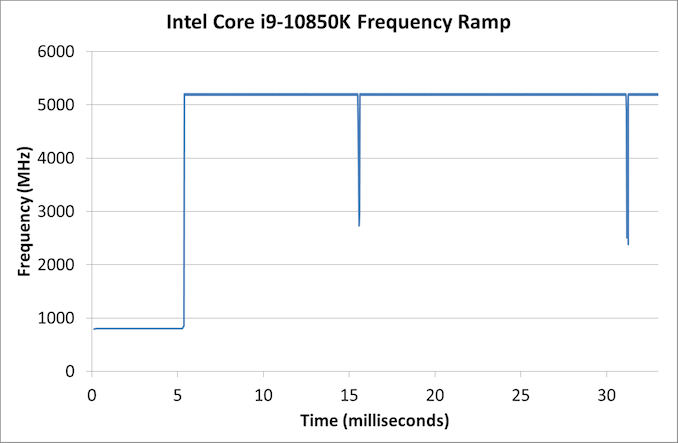Intel Core i9-10850K Review: The Real Intel Flagship
by Dr. Ian Cutress on January 4, 2021 9:00 AM EST- Posted in
- CPUs
- Intel
- Core
- Z490
- 10th Gen Core
- Comet Lake
- LGA1200
- i9-10850K
CPU Tests: Microbenchmarks
Core-to-Core Latency
As the core count of modern CPUs is growing, we are reaching a time when the time to access each core from a different core is no longer a constant. Even before the advent of heterogeneous SoC designs, processors built on large rings or meshes can have different latencies to access the nearest core compared to the furthest core. This rings true especially in multi-socket server environments.
But modern CPUs, even desktop and consumer CPUs, can have variable access latency to get to another core. For example, in the first generation Threadripper CPUs, we had four chips on the package, each with 8 threads, and each with a different core-to-core latency depending on if it was on-die or off-die. This gets more complex with products like Lakefield, which has two different communication buses depending on which core is talking to which.
If you are a regular reader of AnandTech’s CPU reviews, you will recognize our Core-to-Core latency test. It’s a great way to show exactly how groups of cores are laid out on the silicon. This is a custom in-house test built by Andrei, and we know there are competing tests out there, but we feel ours is the most accurate to how quick an access between two cores can happen.
When we first reviewed the 10-core Comet Lake processors, we noticed that a core (or two) seemed to take slightly longer to ping/pong than the others. We see the same pattern here again with the final core.
Frequency Ramping
Both AMD and Intel over the past few years have introduced features to their processors that speed up the time from when a CPU moves from idle into a high powered state. The effect of this means that users can get peak performance quicker, but the biggest knock-on effect for this is with battery life in mobile devices, especially if a system can turbo up quick and turbo down quick, ensuring that it stays in the lowest and most efficient power state for as long as possible.
Intel’s technology is called SpeedShift, although SpeedShift was not enabled until Skylake.
One of the issues though with this technology is that sometimes the adjustments in frequency can be so fast, software cannot detect them. If the frequency is changing on the order of microseconds, but your software is only probing frequency in milliseconds (or seconds), then quick changes will be missed. Not only that, as an observer probing the frequency, you could be affecting the actual turbo performance. When the CPU is changing frequency, it essentially has to pause all compute while it aligns the frequency rate of the whole core.
We wrote an extensive review analysis piece on this, called ‘Reaching for Turbo: Aligning Perception with AMD’s Frequency Metrics’, due to an issue where users were not observing the peak turbo speeds for AMD’s processors.
We got around the issue by making the frequency probing the workload causing the turbo. The software is able to detect frequency adjustments on a microsecond scale, so we can see how well a system can get to those boost frequencies. Our Frequency Ramp tool has already been in use in a number of reviews.
The Core i9-10850K ramps up extremely quickly from idle to peak turbo, in the region of about 5 milliseconds. This is faster than the 16 ms we typically observe.












126 Comments
View All Comments
Otritus - Monday, January 4, 2021 - link
Furthermore, Intel already uses a 1+4 design in their Lakefield processors. So, 1+n designs are possible on x86.It's 2021, when will Anandtech get an edit button.
phoenix_rizzen - Monday, January 4, 2021 - link
What all these graphs show me is that AMD's Zen 3 CPU architecture is a heck of a lot better than Intel's 10th Gen Comet Lake CPU architecture.The 8-core 5800X is within spitting distance of the 10-core 10850K is many benchmarks, and way ahead of it in many others. You pay less upfront, you pay less in power/cooling, and you get better/same performance! Even in multi-threaded benchmarks where the AMD CPU has two fewer cores, but better overall performance.
Hopefully Intel get's their Tiger Lake desktop CPUs (or whatever Lake naming variation the 11th Gen stuff will be) sorted out soon. The only thing holding AMD back right now is supply issues (and a lack of support from the big OEMs like HP, Dell, Compaq, etc).
2021 will be an interesting time for those upgrading desktops... :)
Deicidium369 - Monday, January 4, 2021 - link
"Hopefully Intel get's their Tiger Lake desktop CPUs (or whatever Lake naming variation the 11th Gen stuff will be) sorted out soon" Rocket Lake 11900K is the top SKU and wrecks the 5800X"The only thing holding AMD back right now is supply issues (and a lack of support from the big OEMs like HP, Dell, Compaq, etc)" Compaq? really? You know that Compaq was bought by HP... Maybe Lenovo would have been a better choice there...
Intel provides designs for OEMs - have been doing this since the ultralight era - Intel makes it easy for OEMs to introduce a design using Intel SOCs. AMD does not do this - which is AMD's failing - the OEMs have to spend their own money designing a platform for AMD - and at some point hopefully recoup their investment - the sales volume for AMD is low enough that it often doesn't.
Chicken and Egg - OEMs won't introduce high end AMD designs due to cost, consumers won't be able to purchase a high end AMD - and will instead purchase an Intel.
IF AMD started providing designs and packages of components (like the 1W display for Ice Lake and Tiger Lake 13") to the OEMs - then AMD can start to expect higher end designs, rather than some 15" chassis from 3 years ago - by relieving the OEMs from spending $$ to engineer AMD designs, AMD would remove that burden, and also somewhat dictate what tier these designs go into ... provide the same design to all OEMs (just like Intel does)
This is not bashing AMD - they are missing several tricks to get their product in the high end laptop sector... it's not bribing or anything else - it is SMART BUSINESS.
IF AMD wants it's SOCs in high end designs like the Dell XPS - then it's not difficult to see the path forward.
JayNor - Monday, January 4, 2021 - link
TGL added integrated pcie4, Thunderbolt 4, Wifi6 and lpddr5, and already has avx512, dlboost... all in a laptop chip. When will the competition have those features?RSAUser - Tuesday, January 5, 2021 - link
Interesting that I've seen quite a few high end AMD OEM systems, they can just reuse the design of the Intel counterpart, change is just the mobo and CPU, which doesn't influence Form factor much since can get mobo with same Form factor.powerarmour - Tuesday, January 5, 2021 - link
Just wait until you see the power consumption numbers for Rocket Lake then, you'll then see who wrecks what.Makaveli - Monday, January 4, 2021 - link
Where did you see a 11900k which is unreleased at the moment wrecking a 5800x? Those leaked geekbench scores lol? Citation needed.AndrewJacksonZA - Monday, January 4, 2021 - link
So let me get this straight: A CPU with 65% more cores, 100% more power consumed, and with a 50% greater price than their competitor's smallest and cheapest CPU, is being outperformed or equalled by that little CPU.OK, right on.
JayNor - Monday, January 4, 2021 - link
"Intel likes to point out it has another 24 PCIe 3.0 lanes through the chipset, however this is limited by the DMI/PCIe 3.0 x4 uplink to the processor."Ok, through a switch, but perhaps the OEMs would have to add a switch on the motherboard if Intel only provided four lanes. Seems like a reasonable feature.
Hulk - Monday, January 4, 2021 - link
I loved the article. Well-written, very informative, and entertaining. Also little is ever written when it comes to binning. It's great to hear Ian's thoughts on this and the lengths Intel has been going to in order to stay competitive.Ian presented the facts of the case. We are the jury and make our own decisions.